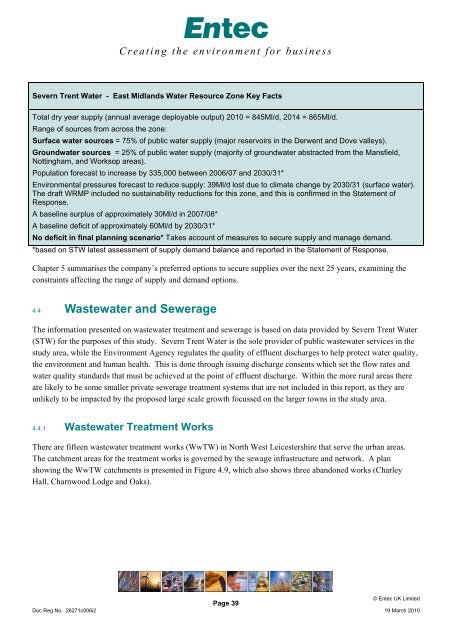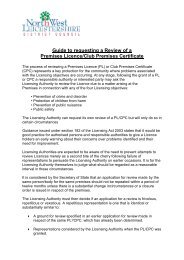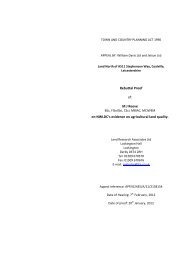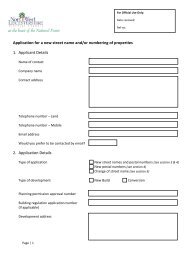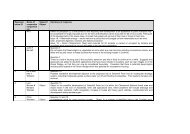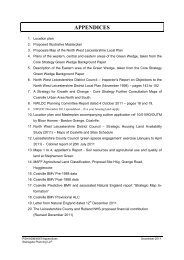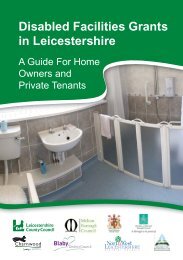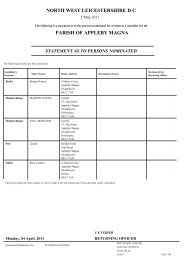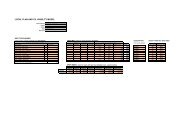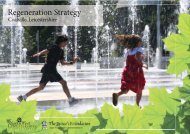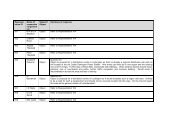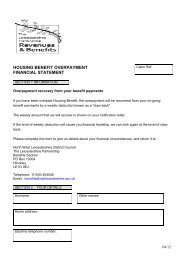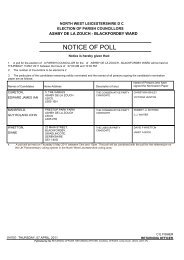Water Cycle Study - March 2010 - North West Leicestershire District ...
Water Cycle Study - March 2010 - North West Leicestershire District ...
Water Cycle Study - March 2010 - North West Leicestershire District ...
You also want an ePaper? Increase the reach of your titles
YUMPU automatically turns print PDFs into web optimized ePapers that Google loves.
Creating the environment for business<br />
Severn Trent <strong>Water</strong> - East Midlands <strong>Water</strong> Resource Zone Key Facts<br />
Total dry year supply (annual average deployable output) <strong>2010</strong> = 845Ml/d, 2014 = 865Ml/d.<br />
Range of sources from across the zone:<br />
Surface water sources = 75% of public water supply (major reservoirs in the Derwent and Dove valleys).<br />
Groundwater sources = 25% of public water supply (majority of groundwater abstracted from the Mansfield,<br />
Nottingham, and Worksop areas).<br />
Population forecast to increase by 335,000 between 2006/07 and 2030/31*<br />
Environmental pressures forecast to reduce supply: 39Ml/d lost due to climate change by 2030/31 (surface water).<br />
The draft WRMP included no sustainability reductions for this zone, and this is confirmed in the Statement of<br />
Response.<br />
A baseline surplus of approximately 30Ml/d in 2007/08*<br />
A baseline deficit of approximately 60Ml/d by 2030/31*<br />
No deficit in final planning scenario* Takes account of measures to secure supply and manage demand.<br />
*based on STW latest assessment of supply demand balance and reported in the Statement of Response.<br />
Chapter 5 summarises the company’s preferred options to secure supplies over the next 25 years, examining the<br />
constraints affecting the range of supply and demand options.<br />
4.4 Wastewater and Sewerage<br />
The information presented on wastewater treatment and sewerage is based on data provided by Severn Trent <strong>Water</strong><br />
(STW) for the purposes of this study. Severn Trent <strong>Water</strong> is the sole provider of public wastewater services in the<br />
study area, while the Environment Agency regulates the quality of effluent discharges to help protect water quality,<br />
the environment and human health. This is done through issuing discharge consents which set the flow rates and<br />
water quality standards that must be achieved at the point of effluent discharge. Within the more rural areas there<br />
are likely to be some smaller private sewerage treatment systems that are not included in this report, as they are<br />
unlikely to be impacted by the proposed large scale growth focussed on the larger towns in the study area.<br />
4.4.1 Wastewater Treatment Works<br />
There are fifteen wastewater treatment works (WwTW) in <strong>North</strong> <strong>West</strong> <strong>Leicestershire</strong> that serve the urban areas.<br />
The catchment areas for the treatment works is governed by the sewage infrastructure and network. A plan<br />
showing the WwTW catchments is presented in Figure 4.9, which also shows three abandoned works (Charley<br />
Hall, Charnwood Lodge and Oaks).<br />
Doc Reg No. 26271c006i2<br />
Page 39<br />
© Entec UK Limited<br />
19 <strong>March</strong> <strong>2010</strong>


